Battle Of The Budget-Friendly Full-Size RWD Luxury Sedans
Today, Hyundai and Chrysler remain in the full-size arena with products that are infinitely more interesting, significantly more powerful and immeasurably more engaging to drive – they also happen to be the only two rear-wheel-drive luxury sedans left in this price segment.
Sensing an interesting fight, we rounded up a 2012 Hyundai Genesis sedan and a 2012 Chrysler 300S for a driving comparison. After several hundred miles of city, canyon and highway had passed swiftly beneath their undercarriages, one clear winner had emerged.
The Hyundai Genesis Sedan and Chrysler 300S are much more alike than they are different.
A quick scan of the automotive marketplace reveals the two as the only "full-size" rear-wheel-drive luxury sedans with a base sticker price of less than $35,000 (hold those comments, as the Dodge Charger isn't considered a "luxury" sedan, and it's largely a twin to the Chrysler anyway). There is nothing less expensive. Above this price bracket resides the full-size BMW 7 Series, Jaguar XJ and the Mercedes-Benz S-Class – at more than double the cost.
While both of these sedans are reasonably priced, their luxury mission stops them short of being true sport sedans (check out the Genesis 5.0 R-Spec and 300 SRT8 to quench those thirsts). Instead, the pair does an admirable job of blending luxury, efficiency, utility and sport – in effect, they are near-perfect family cars for the person who still enjoys the act of driving.
But that is enough dallying, let's get to the comparison.

Assembled in Ulsan, Korea, the five-passenger Hyundai Genesis is fitted with a 3.8-liter V6 rated at 333 horsepower and 291 pound-feet of torque. Power is sent to the rear wheels through a traditional eight-speed automatic transmission (built by Hyundai). The suspension is independent, employing a five-link design at all four corners. Four-wheel disc brakes, ventilated at the front and solid at the rear, are standard. Our test car was wearing 18-inch alloy wheels, wrapped in 235/50R18 Michelin Energy Saver A/S tires. Hyundai lists the curb weight as 3,824 pounds, with a weight distribution of 52 percent front/48 percent rear.
The Genesis 3.8 arrives with a base price of $34,200. Our Titanium Gray Metallic over Black leather test model was equipped with the Technology package ($4,000), which added a 17-speaker Lexicon audio system, navigation with eight-inch display, six-disc DVD changer, Bluetooth, smart cruise control, lane departure warning, HID headlamps, front and rear parking sensors, premium leather and more. It was also fitted with the Premium package ($4,800) that bundles a power moonroof, rear backup camera, power rear sunshade, leather-wrapped dash and other convenience features. Lastly, it was optioned with an iPod cable for the audio system ($35). The bottom line on our 2012 Hyundai Genesis 3.8 sedan was $43,035 including destination.

Assembled in Brampton, Ontario, the five-passenger Chrysler 300S is fitted with a 3.6-liter V6 rated at 292 horsepower and 260 pound-feet of torque. Like the Hyundai, power is also sent to the rear wheels through a eight-speed automatic transmission (ZF 8HP45). The suspension is independent, employing an A-arm arrangement up front and a five-link design at the rear. Four-wheel disc brakes, ventilated at the front and solid at the rear, are standard. Our test car arrived wearing 20-inch alloy wheels, wrapped in 245/45R20 Firestone Firehawk GTV tires. Chrysler lists the curb weight as 4,029 pounds, with a weight distribution of 52 percent front/48 percent rear.
The Chrysler 300S arrived with a base price of $33,170. Our Tungsten Metallic over Radar Red leather test model was equipped with Customer Preferred package 17G ($2,420) that added adaptive cruise control, forward collision warning, bi-xenon headlamps, blind spot detection, rain sensing wipers, driver's memory settings and more. It also featured the Luxury Group ($3,250) bundling leather-trimmed seats, heated steering wheel, heated second-row seats, heated/cooled cup holders, power rear sunshade and other premium equipment. Other stand-alone options included the Dual-Pane Panoramic Sunroof ($1,295) and the Uconnect Touch 8.4N ($795) infotainment and navigation upgrade. The bottom line on our 2012 Chrysler 300S sedan was $41,755 including destination.
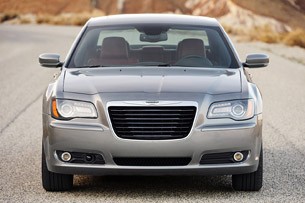
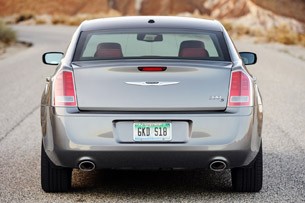
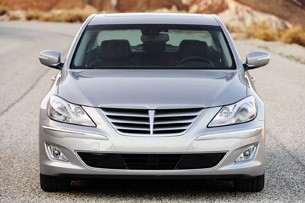
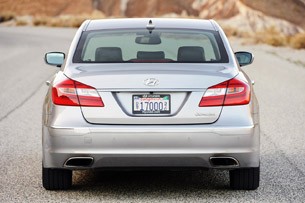
To best compare these two sedans in their natural habitat, we plotted a 250-mile route that would take us across the Los Angeles basin, north through the mountains surrounding Castaic Lake and then across the westernmost part of the Mojave Desert. Three different drivers would each take turns behind the wheel before ending daylight with a photo shoot in Red Rock Canyon State Park. The winner would be debated at a local burger joint.
While nearly matched on paper, these two sedans couldn't be more different in the flesh.
From 30 feet, it was immediately obvious that the Chrysler's design was bold and stylish, while the Hyundai's appearance was sleek and conservative. "The Genesis is the very definition of anonymous, while the 300S is handsome, if perhaps a bit too flashy," pronounced Editor Jeremy Korzeniewski before adding, "Its 18-inch wheels look small compared to the Chrysler's 20-inch alloys, but oddly they fill the wheel wells better." Editor and photographer extraordinaire Drew Phillips mirrored his observations. "The Genesis is a handsome sedan, but it has a generic look that doesn't really want to make you take a second look. On the other hand, the 300's bold look instantly catches your eye. Compared to the first generation 300, the redesigned exterior manages to be both more mature and modern at the same time," noted Phillips.
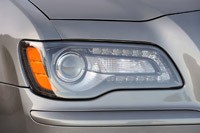
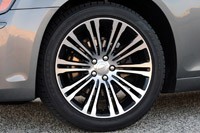
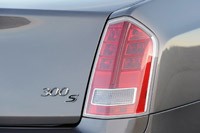
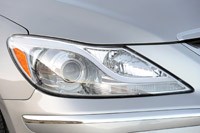
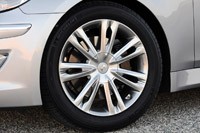
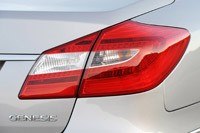
The interiors of each continued the same theme, with the Chrysler again setting a strong tone with its refreshed cabin in valiant red leather - it really made an impression. "Not only is the interior head and shoulders better than the previous 300, but the entire car seems more substantial," said Korzeniewski. "The red seats are certainly eye-catching, although they are a little loud for most buyers," cautioned Phillips. Again, the Genesis took some heat for its bland execution. Not only did its leather feel lower grade, but some of the instruments left us scratching our heads. "The Genesis has an LCD clock that looks like it came from a '90s Timex catalog, and that is not a compliment," quipped Korzeniewski before adding, "The interior buttons, knobs and switches are arranged haphazardly and in too many locations, which makes for unintuitive ergonomics."
Appearance aside, when it came time to actually put our jeans on the seats, we found the Hyundai held a slight advantage. The seats were a bit softer and more accommodating to our frames, and a low beltline meant outward visibility was better in the Genesis. "The low cowl and low door sills, combined with large expanses of glass, make the Genesis much more airy inside and offer excellent visibility. Plus, the rear-seat passenger compartment is cavernous and a very comfortable place to watch the scenery float by," said Korzeniewski, tipping his hat to the much larger rear seating compartment in the Hyundai.
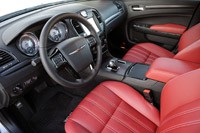
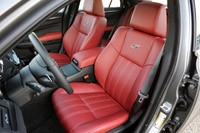
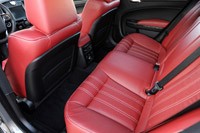
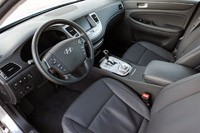
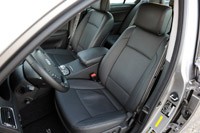
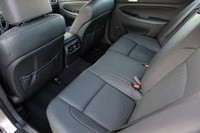
Once we hit the open road, we found that each delivered driving dynamics as distinctive as their physical appearances. Interestingly enough, and despite its heavier 20-inch wheels, the Chrysler did a better job isolating the driver from the outside world. Its ride was smooth and controlled with a chassis that felt well-sorted and stable, almost "vault-like" someone said. The Hyundai's ride was good, but we observed a louder cabin with more pronounced tire howl. We also noted that more wind noise permeated the interior – it may have been because the air was rushing closer to its surface (the drag coefficient of the Genesis is an impressive .27, compared to a more pedestrian .32 for the 300S).
Leaving the highway, we turned each of the sedans towards the mountains. The road was fast, with moderate sweepers that would be enjoyable in a well-sorted sport sedan. However, both four-doors seemed a bit out of their element. The Chrysler felt heavy and planted, but almost too much so when compared to the Hyundai. "Driving the 300 is a little like driving a boat – turn the steering wheel in the direction you want to go, and the front end will eventually get around to pointing in that direction. The Genesis has the more responsive and accurate steering of the two." Phillips commented. The Hyundai delivered better tactile response and felt lighter on its suspension. "I was very surprised by how much road feel made its way through the steering wheel in the Genesis, which, though seemingly out of place for its target market, will be appreciated by driving enthusiasts," added Korzeniewski.
{C}
{C}
But neither the 300S nor the Genesis came across as bona-fide sport sedans. In fact, wearing all-season rubber, both felt increasingly uncomfortable the harder and harder we pushed. At one point, Korzeniewski took one hand off the steering wheel long enough to blurt over the radios that the slippery leather in the Genesis offered less bolstering than his livingroom sofa. "On the rough sections, it was obvious that the 300 has a better ride than the Genesis, soaking up uneven pavement and imperfections in the road with ease – conditions that challenge and upset the Genesis," contributed Phillips. "When driven hard, the Genesis has a harsh, flinty ride that's unbecoming of a luxury sedan," griped Korzeniewski. If forced to pick a better sport sedan, the honor would go to the Hyundai. It was simply more agile and fun to drive thanks to its more responsive steering and slightly lower curb weight. However, all agreed these sedans are far more at home on the highway cruising and not twisty mountain roads.
Back in the desert, the road opened wide and straight. The long highway stretches gave us plenty of time to absorb the sedans' cabins. Both are upscale and well-appointed, but we all felt the Chrysler held the edge, as it was fresher and more stylish with better ergonomics. "The Genesis interior is fairly bland as well, with little to set it apart. While the quality of materials in the interior is up to par, the Genesis cabin is simply a dreary, monotone place to reside. And, without question, the multimedia system in the 300S is the far better of the two (an argument could be made that it's the best in the industry). The graphics may not be cutting edge, but the touchscreen works instantaneously and is simple and easy to use," pointed out Phillips. "Chrysler did a great job paying attention to the little details of the interior. Things like the stitching in the seats, the analog clock on the dash, and the beautiful gauges make the 300's interior the more enjoyable place to be. The cooled cupholders are a nice touch, work well, and they fit a 12-ounce can perfectly," he added.
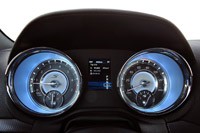
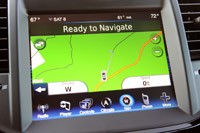
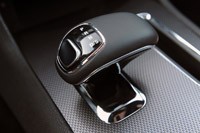
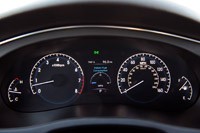
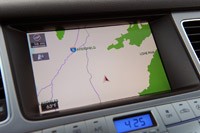
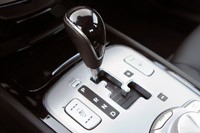
Korzeniewski also raved about the Chrysler's infotainment system. "I'm happy to see the latest Uconnect 8.4-inch touchscreen. It's the best of its kind in the automotive business offering a metric ton of options without a staggering price to match. Though I'm dubious of the benefit of featuring Dr. Dre on the sound system, there's no arguing with the results – pounding bass that doesn't overpower the lighter notes of music makes for a great automotive sound system." Despite our amazement with the Beats audio system, all agreed that the multiple logos plastered all over the interior were a bit much for the 300S's luxury vibe.
While the Chrysler felt confidently quick when flying solo, it was slower than the more powerful Hyundai when driven in formation. We lined them up side-by-side and the 40-plus horsepower advantage was obvious at any speed. The six-cylinder under the hood of the Genesis received plenty of praise. "Power from the 3.8-liter V6 comes on strong at low RPM and continues to build in a linear fashion without running out of breath before the eight-speed automatic goes up a gear," said Korzeniewski. In fact, its flexible output gives little reason to opt for the optional 385-horsepower 4.6-liter V8. While editor Korzeniewski was also content with the Hyundai 3.8-liter, he would gladly give up a couple MPG for the optional 363-horsepower 5.7-liter HEMI offered in the 300S.
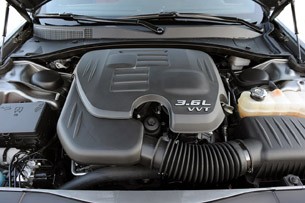
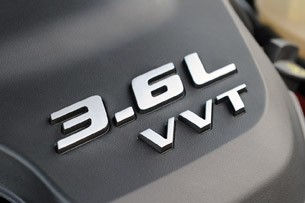
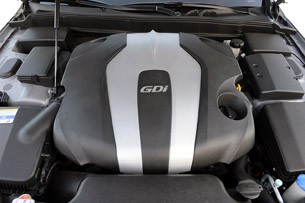
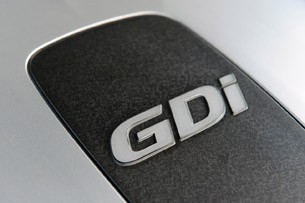
Both cars are fitted with eight-speed automatic transmissions. The 300S shares its ZF-sourced unit with several other luxury vehicles, including the Audi A8. Chrysler has done little to dissuade such comparisons, going so far as to openly ape the T-shaped gear selector from the big German – complete with its vague electronic actuator (the Audi's is still better). "The gear selector, while very stylish, is tough to get used to. More than once I had trouble getting it into the proper gear," said Phillips. Hyundai makes its own gearbox. Impressively smooth around town, we stumbled upon a software gremlin when we floored it in sixth gear on the highway and it dropped with a frightening clunk into fourth for passing. The sound left a dent in our impressions.
Pulling into a service station, we pumped gasoline into each to fill the tanks. The Hyundai took 8.01 gallons of premium unleaded - our error, as Hyundai says the Genesis 3.8 runs just as strongly on regular unleaded - for an overall average of 23.06 mpg (EPA fuel economy rating of 19 mpg city and 29 mpg highway). On the other hand, the Chrysler squeaked by with just 7.55 gallons of regular unleaded for an overall average of 24.45 mpg (EPA fuel economy rating of 19 mpg city and 31 mpg highway). This advantage went inarguably to the 300S.
Over hamburgers and fries at one of Southern California's iconic In-N-Out establishments, we debated the merits of each sedan in an effort to choose a winner.
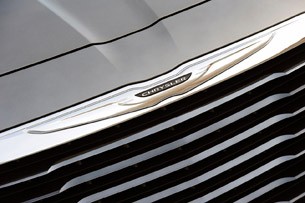
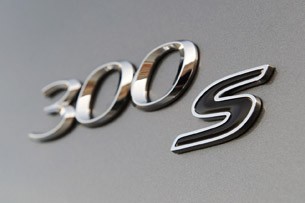
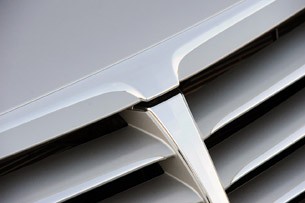
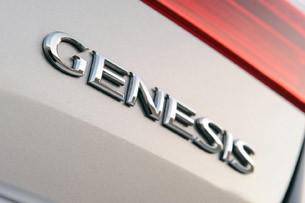
The Genesis was the clear favorite at the start, but it failed to draw us in. "There's nothing really that wrong with the Hyundai Genesis, but there's nothing really that great either. It's hard to find things to complain about, but on the other hand there isn't much to praise, either – nothing really stood out to excite me. It's like Hyundai tried to build a luxury sedan with a formula but didn't put any emotion into it," mused Phillips. "It is still a credible alternative luxury sedan, but we were let down by some forgotten details, its less-than-perfect ride and unimaginative styling," added Korzeniewski.
The Chrysler was the underdog, but it worked its magic on the team. "The 300S is the best highway cruiser in its class and it seamlessly combines a very American sense of style with Euro-flavored fit, finish and comfort. The ride is good, without being floaty. Despite being down on power, it never felt like it was stressed," noted Korzeniewski. "There's a part of me that still wants to reject the 300 because of the faults of the last generation car, but the current car is surprisingly good. If Chrysler did anything right with the new 300, it's that they put a fantastic interior into the car. It's both comfortable and beautiful, and they paid attention to all of the little details. And the multimedia/navigation system is fantastic," observed Phillips. Plus, we all agreed that the Chrysler held a few more solid cards: It offers four-season capability with its optional all-wheel-drive system, it runs on regular unleaded fuel and it appeals to a younger audience.
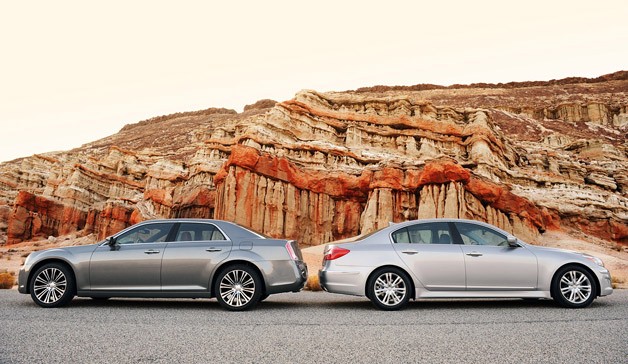
Before our long day behind the wheel, most felt the Genesis was going to take home the trophy. However, after a couple hours of discussion and reviewing notes, all three of us put the Chrysler 300S at the top. The decision wasn't based on sticker price (a mere $1,280 separates the two) or performance (the Hyundai wins that round) but on our gut feelings.
Editor Phillips summed it up well, "The 300S simply makes that connection better with its bold exterior styling and beautiful interior. It's comfortable, smooth and quiet, and you're going to look good driving it. Plus, the stereo rocks." It all boiled down to emotion – that intangible, yet important, criteria most buyers rely on before writing that final big check.
Why compare a Hyundai to a Chrysler? At first glance, this matchup may seem rather preposterous, but a logical argument says this rivalry has been in place for more than a decade. In 2002, Chrysler and Hyundai were both offering full-size front-wheel-drive sedans. Hyundai had its XG350 fitted with a 194-horsepower 3.5-liter V6, while Chrysler was touting its Concorde with a 214-horsepower 3.5-liter V6 (each shared an EPA rating of 16 mpg city and 24 mpg highway). Not only were both remarkably similar on paper, but both sedans started at about $25,000.The Hyundai Genesis Sedan and Chrysler 300S are much more alike than they are different.
Today, Hyundai and Chrysler remain in the full-size arena with products that are infinitely more interesting, significantly more powerful and immeasurably more engaging to drive – they also happen to be the only two rear-wheel-drive luxury sedans left in this price segment.
Sensing an interesting fight, we rounded up a 2012 Hyundai Genesis sedan and a 2012 Chrysler 300S for a driving comparison. After several hundred miles of city, canyon and highway had passed swiftly beneath their undercarriages, one clear winner had emerged.
The Hyundai Genesis Sedan and Chrysler 300S are much more alike than they are different.
A quick scan of the automotive marketplace reveals the two as the only "full-size" rear-wheel-drive luxury sedans with a base sticker price of less than $35,000 (hold those comments, as the Dodge Charger isn't considered a "luxury" sedan, and it's largely a twin to the Chrysler anyway). There is nothing less expensive. Above this price bracket resides the full-size BMW 7 Series, Jaguar XJ and the Mercedes-Benz S-Class – at more than double the cost.
While both of these sedans are reasonably priced, their luxury mission stops them short of being true sport sedans (check out the Genesis 5.0 R-Spec and 300 SRT8 to quench those thirsts). Instead, the pair does an admirable job of blending luxury, efficiency, utility and sport – in effect, they are near-perfect family cars for the person who still enjoys the act of driving.
But that is enough dallying, let's get to the comparison.

Assembled in Ulsan, Korea, the five-passenger Hyundai Genesis is fitted with a 3.8-liter V6 rated at 333 horsepower and 291 pound-feet of torque. Power is sent to the rear wheels through a traditional eight-speed automatic transmission (built by Hyundai). The suspension is independent, employing a five-link design at all four corners. Four-wheel disc brakes, ventilated at the front and solid at the rear, are standard. Our test car was wearing 18-inch alloy wheels, wrapped in 235/50R18 Michelin Energy Saver A/S tires. Hyundai lists the curb weight as 3,824 pounds, with a weight distribution of 52 percent front/48 percent rear.
The Genesis 3.8 arrives with a base price of $34,200. Our Titanium Gray Metallic over Black leather test model was equipped with the Technology package ($4,000), which added a 17-speaker Lexicon audio system, navigation with eight-inch display, six-disc DVD changer, Bluetooth, smart cruise control, lane departure warning, HID headlamps, front and rear parking sensors, premium leather and more. It was also fitted with the Premium package ($4,800) that bundles a power moonroof, rear backup camera, power rear sunshade, leather-wrapped dash and other convenience features. Lastly, it was optioned with an iPod cable for the audio system ($35). The bottom line on our 2012 Hyundai Genesis 3.8 sedan was $43,035 including destination.

Assembled in Brampton, Ontario, the five-passenger Chrysler 300S is fitted with a 3.6-liter V6 rated at 292 horsepower and 260 pound-feet of torque. Like the Hyundai, power is also sent to the rear wheels through a eight-speed automatic transmission (ZF 8HP45). The suspension is independent, employing an A-arm arrangement up front and a five-link design at the rear. Four-wheel disc brakes, ventilated at the front and solid at the rear, are standard. Our test car arrived wearing 20-inch alloy wheels, wrapped in 245/45R20 Firestone Firehawk GTV tires. Chrysler lists the curb weight as 4,029 pounds, with a weight distribution of 52 percent front/48 percent rear.
The Chrysler 300S arrived with a base price of $33,170. Our Tungsten Metallic over Radar Red leather test model was equipped with Customer Preferred package 17G ($2,420) that added adaptive cruise control, forward collision warning, bi-xenon headlamps, blind spot detection, rain sensing wipers, driver's memory settings and more. It also featured the Luxury Group ($3,250) bundling leather-trimmed seats, heated steering wheel, heated second-row seats, heated/cooled cup holders, power rear sunshade and other premium equipment. Other stand-alone options included the Dual-Pane Panoramic Sunroof ($1,295) and the Uconnect Touch 8.4N ($795) infotainment and navigation upgrade. The bottom line on our 2012 Chrysler 300S sedan was $41,755 including destination.




To best compare these two sedans in their natural habitat, we plotted a 250-mile route that would take us across the Los Angeles basin, north through the mountains surrounding Castaic Lake and then across the westernmost part of the Mojave Desert. Three different drivers would each take turns behind the wheel before ending daylight with a photo shoot in Red Rock Canyon State Park. The winner would be debated at a local burger joint.
While nearly matched on paper, these two sedans couldn't be more different in the flesh.
From 30 feet, it was immediately obvious that the Chrysler's design was bold and stylish, while the Hyundai's appearance was sleek and conservative. "The Genesis is the very definition of anonymous, while the 300S is handsome, if perhaps a bit too flashy," pronounced Editor Jeremy Korzeniewski before adding, "Its 18-inch wheels look small compared to the Chrysler's 20-inch alloys, but oddly they fill the wheel wells better." Editor and photographer extraordinaire Drew Phillips mirrored his observations. "The Genesis is a handsome sedan, but it has a generic look that doesn't really want to make you take a second look. On the other hand, the 300's bold look instantly catches your eye. Compared to the first generation 300, the redesigned exterior manages to be both more mature and modern at the same time," noted Phillips.






The interiors of each continued the same theme, with the Chrysler again setting a strong tone with its refreshed cabin in valiant red leather - it really made an impression. "Not only is the interior head and shoulders better than the previous 300, but the entire car seems more substantial," said Korzeniewski. "The red seats are certainly eye-catching, although they are a little loud for most buyers," cautioned Phillips. Again, the Genesis took some heat for its bland execution. Not only did its leather feel lower grade, but some of the instruments left us scratching our heads. "The Genesis has an LCD clock that looks like it came from a '90s Timex catalog, and that is not a compliment," quipped Korzeniewski before adding, "The interior buttons, knobs and switches are arranged haphazardly and in too many locations, which makes for unintuitive ergonomics."
Appearance aside, when it came time to actually put our jeans on the seats, we found the Hyundai held a slight advantage. The seats were a bit softer and more accommodating to our frames, and a low beltline meant outward visibility was better in the Genesis. "The low cowl and low door sills, combined with large expanses of glass, make the Genesis much more airy inside and offer excellent visibility. Plus, the rear-seat passenger compartment is cavernous and a very comfortable place to watch the scenery float by," said Korzeniewski, tipping his hat to the much larger rear seating compartment in the Hyundai.



The Chrysler's red seats are eye-catching, though a little loud for most buyers.



The Genesis offers excellent visibility and a cavernous rear seat.
Once we hit the open road, we found that each delivered driving dynamics as distinctive as their physical appearances. Interestingly enough, and despite its heavier 20-inch wheels, the Chrysler did a better job isolating the driver from the outside world. Its ride was smooth and controlled with a chassis that felt well-sorted and stable, almost "vault-like" someone said. The Hyundai's ride was good, but we observed a louder cabin with more pronounced tire howl. We also noted that more wind noise permeated the interior – it may have been because the air was rushing closer to its surface (the drag coefficient of the Genesis is an impressive .27, compared to a more pedestrian .32 for the 300S).
Leaving the highway, we turned each of the sedans towards the mountains. The road was fast, with moderate sweepers that would be enjoyable in a well-sorted sport sedan. However, both four-doors seemed a bit out of their element. The Chrysler felt heavy and planted, but almost too much so when compared to the Hyundai. "Driving the 300 is a little like driving a boat – turn the steering wheel in the direction you want to go, and the front end will eventually get around to pointing in that direction. The Genesis has the more responsive and accurate steering of the two." Phillips commented. The Hyundai delivered better tactile response and felt lighter on its suspension. "I was very surprised by how much road feel made its way through the steering wheel in the Genesis, which, though seemingly out of place for its target market, will be appreciated by driving enthusiasts," added Korzeniewski.
{C}
But neither the 300S nor the Genesis came across as bona-fide sport sedans. In fact, wearing all-season rubber, both felt increasingly uncomfortable the harder and harder we pushed. At one point, Korzeniewski took one hand off the steering wheel long enough to blurt over the radios that the slippery leather in the Genesis offered less bolstering than his livingroom sofa. "On the rough sections, it was obvious that the 300 has a better ride than the Genesis, soaking up uneven pavement and imperfections in the road with ease – conditions that challenge and upset the Genesis," contributed Phillips. "When driven hard, the Genesis has a harsh, flinty ride that's unbecoming of a luxury sedan," griped Korzeniewski. If forced to pick a better sport sedan, the honor would go to the Hyundai. It was simply more agile and fun to drive thanks to its more responsive steering and slightly lower curb weight. However, all agreed these sedans are far more at home on the highway cruising and not twisty mountain roads.
Back in the desert, the road opened wide and straight. The long highway stretches gave us plenty of time to absorb the sedans' cabins. Both are upscale and well-appointed, but we all felt the Chrysler held the edge, as it was fresher and more stylish with better ergonomics. "The Genesis interior is fairly bland as well, with little to set it apart. While the quality of materials in the interior is up to par, the Genesis cabin is simply a dreary, monotone place to reside. And, without question, the multimedia system in the 300S is the far better of the two (an argument could be made that it's the best in the industry). The graphics may not be cutting edge, but the touchscreen works instantaneously and is simple and easy to use," pointed out Phillips. "Chrysler did a great job paying attention to the little details of the interior. Things like the stitching in the seats, the analog clock on the dash, and the beautiful gauges make the 300's interior the more enjoyable place to be. The cooled cupholders are a nice touch, work well, and they fit a 12-ounce can perfectly," he added.



The touchscreen in the 300S works instantaneously and is simple to use.



The Genesis interior is fairly bland, with little to set it apart.
Korzeniewski also raved about the Chrysler's infotainment system. "I'm happy to see the latest Uconnect 8.4-inch touchscreen. It's the best of its kind in the automotive business offering a metric ton of options without a staggering price to match. Though I'm dubious of the benefit of featuring Dr. Dre on the sound system, there's no arguing with the results – pounding bass that doesn't overpower the lighter notes of music makes for a great automotive sound system." Despite our amazement with the Beats audio system, all agreed that the multiple logos plastered all over the interior were a bit much for the 300S's luxury vibe.
While the Chrysler felt confidently quick when flying solo, it was slower than the more powerful Hyundai when driven in formation. We lined them up side-by-side and the 40-plus horsepower advantage was obvious at any speed. The six-cylinder under the hood of the Genesis received plenty of praise. "Power from the 3.8-liter V6 comes on strong at low RPM and continues to build in a linear fashion without running out of breath before the eight-speed automatic goes up a gear," said Korzeniewski. In fact, its flexible output gives little reason to opt for the optional 385-horsepower 4.6-liter V8. While editor Korzeniewski was also content with the Hyundai 3.8-liter, he would gladly give up a couple MPG for the optional 363-horsepower 5.7-liter HEMI offered in the 300S.


The 300S' 3.6L V6 produces 292 horsepower and 260 pound-feet of torque.


The Genesis' 3.8L V6 produces 333 horsepower and 291 pound-feet of torque.
Both cars are fitted with eight-speed automatic transmissions. The 300S shares its ZF-sourced unit with several other luxury vehicles, including the Audi A8. Chrysler has done little to dissuade such comparisons, going so far as to openly ape the T-shaped gear selector from the big German – complete with its vague electronic actuator (the Audi's is still better). "The gear selector, while very stylish, is tough to get used to. More than once I had trouble getting it into the proper gear," said Phillips. Hyundai makes its own gearbox. Impressively smooth around town, we stumbled upon a software gremlin when we floored it in sixth gear on the highway and it dropped with a frightening clunk into fourth for passing. The sound left a dent in our impressions.
Pulling into a service station, we pumped gasoline into each to fill the tanks. The Hyundai took 8.01 gallons of premium unleaded - our error, as Hyundai says the Genesis 3.8 runs just as strongly on regular unleaded - for an overall average of 23.06 mpg (EPA fuel economy rating of 19 mpg city and 29 mpg highway). On the other hand, the Chrysler squeaked by with just 7.55 gallons of regular unleaded for an overall average of 24.45 mpg (EPA fuel economy rating of 19 mpg city and 31 mpg highway). This advantage went inarguably to the 300S.
Over hamburgers and fries at one of Southern California's iconic In-N-Out establishments, we debated the merits of each sedan in an effort to choose a winner.




The Genesis was the clear favorite at the start, but it failed to draw us in. "There's nothing really that wrong with the Hyundai Genesis, but there's nothing really that great either. It's hard to find things to complain about, but on the other hand there isn't much to praise, either – nothing really stood out to excite me. It's like Hyundai tried to build a luxury sedan with a formula but didn't put any emotion into it," mused Phillips. "It is still a credible alternative luxury sedan, but we were let down by some forgotten details, its less-than-perfect ride and unimaginative styling," added Korzeniewski.
The Chrysler was the underdog, but it worked its magic on the team. "The 300S is the best highway cruiser in its class and it seamlessly combines a very American sense of style with Euro-flavored fit, finish and comfort. The ride is good, without being floaty. Despite being down on power, it never felt like it was stressed," noted Korzeniewski. "There's a part of me that still wants to reject the 300 because of the faults of the last generation car, but the current car is surprisingly good. If Chrysler did anything right with the new 300, it's that they put a fantastic interior into the car. It's both comfortable and beautiful, and they paid attention to all of the little details. And the multimedia/navigation system is fantastic," observed Phillips. Plus, we all agreed that the Chrysler held a few more solid cards: It offers four-season capability with its optional all-wheel-drive system, it runs on regular unleaded fuel and it appeals to a younger audience.

Before our long day behind the wheel, most felt the Genesis was going to take home the trophy. However, after a couple hours of discussion and reviewing notes, all three of us put the Chrysler 300S at the top. The decision wasn't based on sticker price (a mere $1,280 separates the two) or performance (the Hyundai wins that round) but on our gut feelings.
Editor Phillips summed it up well, "The 300S simply makes that connection better with its bold exterior styling and beautiful interior. It's comfortable, smooth and quiet, and you're going to look good driving it. Plus, the stereo rocks." It all boiled down to emotion – that intangible, yet important, criteria most buyers rely on before writing that final big check.










Sign in to post
Please sign in to leave a comment.
Continue